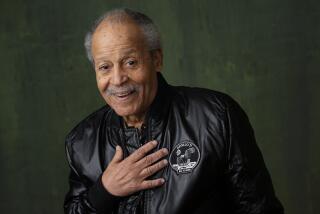Survivor of ’88 Air Show Crash Fulfilled Dream of Returning to Skies
CHINO — When Marine Corps Col. Jerry Cadick’s jet slammed into the ground at the El Toro Air Show five years ago, his prognosis was not good. His neck was broken in three places. He had a fractured arm. Five shattered ribs. A crushed vertebra. Two broken legs. Both ankles splintered.
Spectators thought he had not survived. Surgeons thought he wouldn’t walk. But Cadick always maintained he would return to the cockpit. Six months later, he was flying again.
When Cadick heard Sunday that a fellow aviator had crashed and died while performing at Sunday’s air show, he grieved for the family, he said. But he and other pilots, Cadick said, are trained to analyze what went wrong without dwelling on tragedy.
“Most fighter pilots are not big on emotion,” Cadick said. Because the job is inherently stressful and at times fatal, fighter pilots are taught to hold their emotions in check. “You must be in control 100% of the time or you’re going to die,” he said.
After Sunday’s crash, Cadick said, “I was looking at the maneuver like every other air show pilot,” trying to assess the error.
While performing a solo maneuver called a Square Immelman at the air show on April 24, 1988, Cadick lost orientation and crashed his F/A-18 Hornet.
The crash ended Cadick’s 26-year military career and a chance to become a brigadier general, but the San Clemente resident has rebounded. He was flying for recreation within months after the accident, and today he is trying to market to the military a product he created to better simulate missile fire during mock aerial dogfights. The device uses lasers and smoke so fighter pilots can know while airborne if they have scored a hit, said Cadick, who is president of Tactical Military Air Training Systems.
While Cadick called it exciting to be an entrepreneur and owner of his own company, he said it was the thought of flying that fueled his desire for a comeback. “Flying was like the magic pill from the hospital,” he said.
Six months after the crash, Cadick’s dream became a reality. He returned to the sky and flew mock dogfights with a friend for 30 minutes, experiencing no fear.
“I was absolutely ecstatic,” he said. “It’s what I had dreamed about all the time in the hospital.”
The road to Cadick’s recovery was long, and not without pain. “I broke everything but my earlobes,” he said. He suffered from muscle atrophy as a result of being strapped to a hospital bed for 14 weeks. Rehabilitation included relearning how to walk.
Although he accepted the reality of his numerous injuries, he refused to accept doctors’ predictions that he would never fully recover.
“You will become disabled if you think you are,” he said.
Cadick no longer attends therapy sessions; those stopped in the summer of 1989. Today, he walks with a slight limp. Dozens of screws hold his lower spine and both ankles together.
He is active--bike riding or lifting weights several times a week and flying about 15 hours a month, not quite the monthly average of 20 to 25 hours for military pilots.
During his military career, Cadick said, he became acquainted with air show pilots.
“I was really impressed with how professional the pilots are. . . . The people that do the flying are very level-headed. Public opinion of that business is only as good as the weakest man.”
More to Read
Sign up for Essential California
The most important California stories and recommendations in your inbox every morning.
You may occasionally receive promotional content from the Los Angeles Times.










